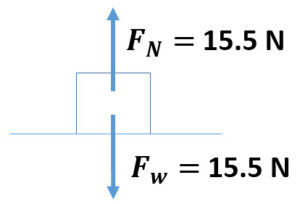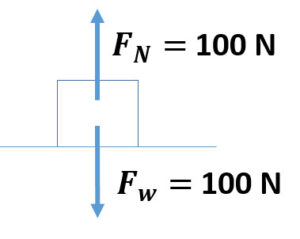Mass and Weight
Learn the difference between mass (m) and weight (Fw). Find out how to convert to mass from weight and from weight to mass.
Watch the video as we go through the content and problems set or go through the same material below
Learning Targets
- I know the difference between mass and weight
- I can calculate mass from weight and weight from mass using Fw = mg
- I can draw a Force Diagram of an object on a horizontal surface of any planet
Mass is a measurement of matter (molecular composition) of an object. Since an objects molecular composition remains when location changes, mass never changes.
Weight is a measure of the force of gravity on an objects mass. This is directly related to mass but will change with location as the force and acceleration due to gravity changes.
Weight equals mass times gravity
Fw = mg
| Name | Variable | Unit | Unit abbreviation |
| Weight | Fw | Newton | N |
| Mass | m | kilogram | kg |
| Acceleration due to gravity | g | Meters per second squared | m/s2 |
- On the Earth's surface, the accepted value for acceleration due to gravity (g) is 9.81 m/s2
- In some lessons we had you use a less specific rounded number of 10 m/s2
Weight Changes When (g) Changes
On Earth, your weight is caused by the earths pull on you. In a future lesson we will see that weight is the result of the your mass, the earths mass, and the distance between you and Earth.
We will solve problems on this page using an average surface acceleration due to gravity
- More massive interstellar objects have a higher surface acceleration due to gravity (g).
- The higher the acceleration due to gravity (g) the higher the weight (Fw)
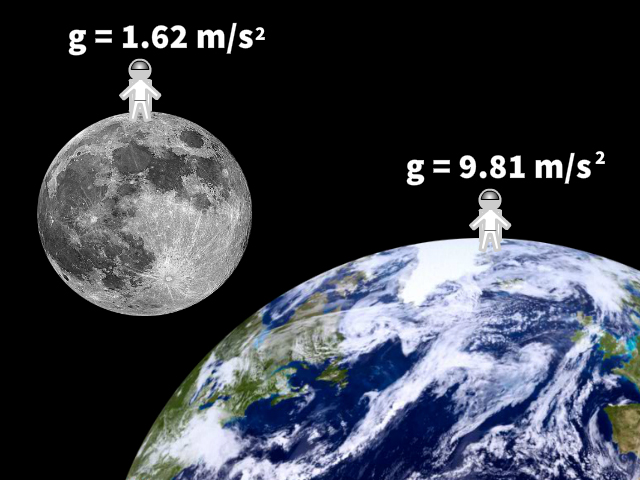
Mass, Radius, and Acceleration due to Gravity of Planets
| Planet | Mass (kg) | Radius (m) | Surface Acceleration due to Gravity (m/s2) |
| Mercury | 3.29 x 1023 | 2.440 x 106 | 3.70 |
| Venus | 4.87 x 1024 | 6.052 x 106 | 8.88 |
| Earth | 5.97 x 1024 | 6.378 x 106 | 9.81 |
| Mars | 6.39 x 1023 | 3.396 x 106 | 3.72 |
| Jupiter | 1.90 x 1027 | 7.149 x 107 | 24.79 |
| Saturn | 5.68 x 1026 | 6.027 x 107 | 10.44 |
| Uranus | 8.68 x 1025 | 2.556 x 107 | 8.69 |
| Neptune | 1.02 x 1026 | 2.476 x 107 | 11.15 |
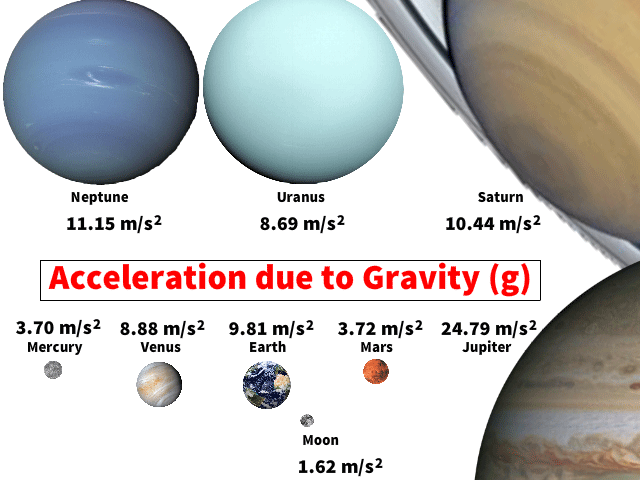
Mass, Radius, and Acceleration due to Gravity of Other Interstellar Objects
| Interstellar Object | Mass | Radius (m) | Surface Acceleration due to Gravity (m/s2) |
| Sun | 1.99 x 1030 | 6.963 x 108 | 274.78 |
| Earth’s Moon | 7.35 x 1022 | 1.738 x 106 | 1.62 |
| Pluto | 1.31 x 1022 | 1.195 x 106 | 0.62 |
Example Questions (Mass and Weight)
1. What is 76 kg Natalia's weight on earth where the acceleration due to gravity is 9.81 m/s2?
2. What is Natalia's weight on the moon where the acceleration due to gravity is 1.62 m/s2?
3. If 76 kg Natalia went to Neptune where the surface acceleration due to gravity is 11.15 m/s2, would her mass or weight change and what would each be?
Normal Force Equals Weight on a Horizontal Surface
Notice in the force diagrams:
- Mass (m) of 10 kg does not change
- Weight (Fw) changes with the acceleration due to gravity
- The normal (FN)force changes with weight (Fw)
Normal force is the force created by weight on a surface pushing back upwards perpendicular to the surface. Perpendicular to any horizontal surface will be up.
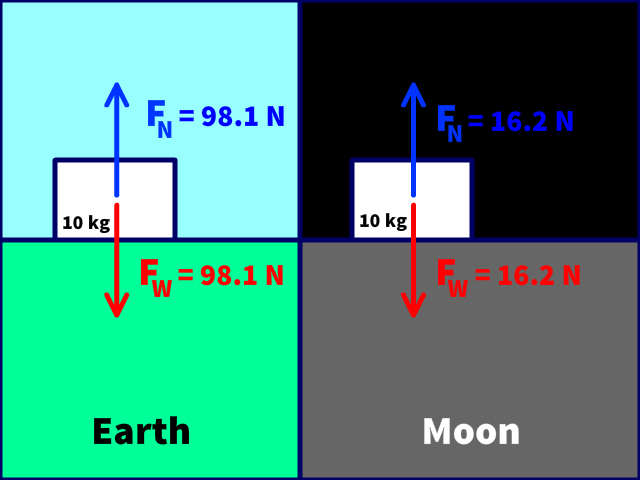
Problem Set
1. What is the weight of a 25 kg object on Pluto where the acceleration due to gravity is 0.62 m/s2?
2. Draw a force diagram including the normal force of this 25 kg object on a horizontal surface of Pluto where the acceleration due to gravity is 0.62 m/s2?
3. What is the mass of a 25 kg object on Pluto where the acceleration due to gravity is 0.62 m/s2?
4. What is the weight of a 25 kg object on Mars where the acceleration due to gravity is 3.72 m/s2?
5. What is the mass of a 100 N object on the Moon where the acceleration due to gravity is 1.62 m/s2?
6. Draw a force diagram including the normal force of a 100 N object on the surface of the Moon where the acceleration due to gravity is 1.62 m/s2?
7. If you weigh 1177.2 N on Earth where the acceleration due to gravity is 9.81 m/s2 what is your mass on Uranus where the acceleration due to gravity is 8.69 m/s2?
8. If you weigh 1177.2 N on Earth where the acceleration due to gravity is 9.81 m/s2 what is your weight on Uranus where the acceleration due to gravity is 8.69 m/s2?
Links
- Continue to Newton's Third Law
- Back to the Main Forces Page
- Back to the Stickman Physics Home Page
- Equation Sheet

